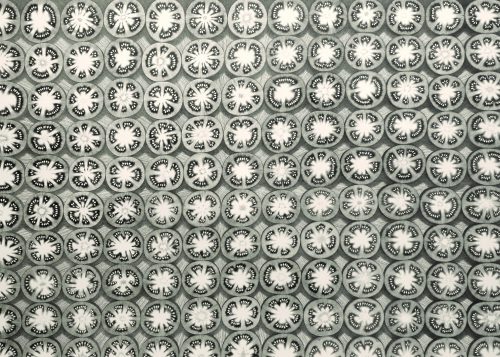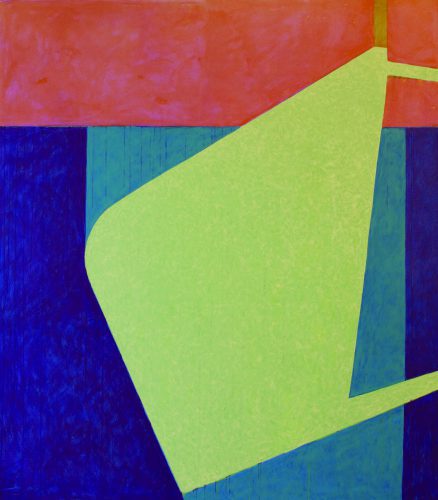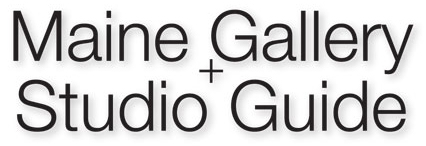The University of Maine Museum of Art, located at 40 Harlow Street in downtown Bangor, opens three new exhibitions in January. UMMA is open Tuesday-Saturday from 10 am – 5 pm and brings modern and contemporary art to the region, presenting approximately 12 original exhibitions each year. UMMA’s winter shows open to the public on January 18 and runs through May 4, 2019. Admission to the Museum of Art is free in 2019 thanks to the generosity of Deighan Wealth Advisors.
REVERSIBLE ROLES: MEGHAN BRADY

Meghan Brady’s large-scale paintings and collages are brought to life through intense color saturation and dynamic, abstract forms. The compositions are vibrantly structured with unadulterated blues, intense yellows, and oranges. The focal point of the exhibition is a work titled Everyday that spans over 16 feet and explores shape and form on a grand scale. The artist states, “The container form—human or otherwise—is a jumping off point to do what I want to do, which is to construct, deconstruct, and hopefully land somewhere totally unexpected.” Brady also layers bold colors, such as acidic green over deep blue, as a means of creating unique shapes in her compelling compositions. The use of saturated color and powerful gestural marks articulate Brady’s exploration of energetic geometric forms and how they relate to each other.
The selected works of Reversible Roles involve both the concept of representation and abstraction and explore how the negative spaces—the spaces created between and around color—can become the focal point of the piece. Brady explains, “Negative shapes are the by-product of cutting shapes from canvas and these shapes transform from negative to positive in the course of one quick decision.” These works are the culmination of Brady’s practice of working with diverse media, including ceramics, woodcut, collage, and oil paint as a means of expanding her creative praxis and extending her process. Brady adds, “Reversible Roles is about the possibility of upending expectations by swapping places. Or in the case of painting, turning them upside down, placing them on the floor, or cutting them in half.” Producing works of this size is a challenging endeavor. The physicality of this process is like a dance between artist and canvas and this corporeality infuses the paintings with energy, spirit, and life.

Boston-based artist Zach Horn has created an exhibition where food and landscape take center stage. Horn has depicted key ingredients of a picnic: a watermelon, sliced cucumbers, a hot dog, bowls of spaghetti and even a life-sized gingham blanket. A massive graphite drawing of a cave functions like a backdrop that allows the viewer to almost step into the scene. In another area, the viewer confronts a three-dimensional sculpture of a yellow-hued mountain range that curiously projects from the wall.
Pattern and repetition are prominently featured throughout these selected works. In the large graphite drawing Tomatoes, 2018, the artist has meticulously rendered slices of tomatoes placed in perfect rows. Horn states, “The food pictures are arranged in symmetrical abstraction, often with a closed composition. It’s recognizable form, but it is couched in the language of spiritual abstraction: patterns, mandalas, the grid, and the sublime landscape”. The artist’s celebration of routine daily tasks and the importance of coming together around food have inspired these compositions. The repetitive act of carefully preparing ingredients for the family meal may be a ruminative experience, just as drawing may be a meditative act. Ultimately, Horn invites the viewer to contemplate feelings evoked through food and the environment.

Maine-based artist Richard Keen explores abstraction in both paintings and mixed media, wall-oriented sculptures. Keen states that “experiences are brought into focus by removing unnecessary detail, often simplifying the world into line, shape, color and texture.” In his paintings there are often predominant solid shapes, sometimes further accentuated by precisely painted pin-striped lines, that occupy other expanses of color. Imbued with order and clarity, the angular forms in Keen’s paintings seem to be derived from aerial views of the landscape. Dominant central shapes often have smaller lines that are like pathways or roads, leading the eye off the picture plane.Shapes that emerge in Keen’s paintings inform his wall sculptures—often incorporating surfaces created by sanding though successive layers of paint. Originally inspired by the undersides of boats being stripped of paint, Keen’s revelation of these layers of history is integral to his process. The quirky, enigmatic forms created by the artist integrate objects such discarded wood and other found materials. Using polyester resin, fillers and spray enamel, Keen brings together these contrasting surfaces within his singular compositions.

